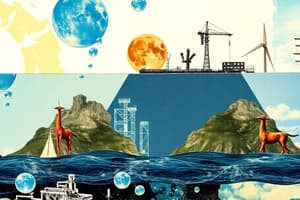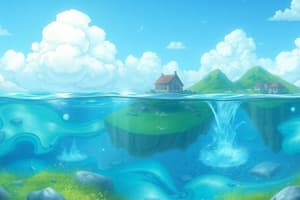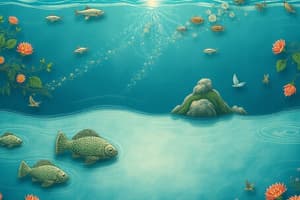Podcast
Questions and Answers
What is a characteristic feature of a Guyot?
What is a characteristic feature of a Guyot?
- High elevation
- Rugged terrain
- Vertical cliffs
- Flat top (correct)
Which stage of the Wilson Cycle is characterized by narrow seaways with central depressions?
Which stage of the Wilson Cycle is characterized by narrow seaways with central depressions?
- Young ocean (correct)
- Embryonic rift
- Mature ocean
- Declining ocean
What is released from hydrothermal vents on the ocean floor?
What is released from hydrothermal vents on the ocean floor?
- Saltwater
- High-pressure steam
- Cool freshwater
- Heated mineral-rich water (correct)
What is a feature of a declining ocean in the Wilson Cycle?
What is a feature of a declining ocean in the Wilson Cycle?
What defines a mature ocean in the Wilson Cycle?
What defines a mature ocean in the Wilson Cycle?
What percentage of Earth's water is classified as freshwater?
What percentage of Earth's water is classified as freshwater?
Which of the following water types is primarily used for medical sterilization purposes?
Which of the following water types is primarily used for medical sterilization purposes?
What process occurs when water vapor cools and forms clouds?
What process occurs when water vapor cools and forms clouds?
Where is the majority of Earth's freshwater stored?
Where is the majority of Earth's freshwater stored?
Which type of water is essential for crop irrigation and livestock maintenance?
Which type of water is essential for crop irrigation and livestock maintenance?
Which step in the Hydrologic Cycle directly follows evaporation?
Which step in the Hydrologic Cycle directly follows evaporation?
What percentage of Earth's water is saline and found primarily in the oceans?
What percentage of Earth's water is saline and found primarily in the oceans?
What is the movement of water through porous rocks and soil known as?
What is the movement of water through porous rocks and soil known as?
What type of stress occurs when two blocks of rock are pushed toward each other?
What type of stress occurs when two blocks of rock are pushed toward each other?
Which concept involves the study of magnetism in rocks to understand Earth's magnetic history?
Which concept involves the study of magnetism in rocks to understand Earth's magnetic history?
What type of fault occurs when rocks slide past each other horizontally?
What type of fault occurs when rocks slide past each other horizontally?
Which of the following is a characteristic of ductile deformation?
Which of the following is a characteristic of ductile deformation?
Which hypothesis suggests that continents were originally connected and then drifted apart?
Which hypothesis suggests that continents were originally connected and then drifted apart?
How does shearing stress affect rocks?
How does shearing stress affect rocks?
What evidence supports the theory of continental drift with regards to fossils?
What evidence supports the theory of continental drift with regards to fossils?
What is an example of a landform created by compression?
What is an example of a landform created by compression?
What exacerbates soil contamination according to land management practices?
What exacerbates soil contamination according to land management practices?
Which type of erosion is primarily associated with coastal areas?
Which type of erosion is primarily associated with coastal areas?
How do plants contribute to the prevention of soil erosion?
How do plants contribute to the prevention of soil erosion?
Which factor does NOT contribute to the erodibility of soil?
Which factor does NOT contribute to the erodibility of soil?
What percentage of land in the Philippines is covered by Ultisols?
What percentage of land in the Philippines is covered by Ultisols?
Which crop is NOT mentioned as being grown on agricultural land in the Philippines?
Which crop is NOT mentioned as being grown on agricultural land in the Philippines?
What is a possible consequence of overgrazing?
What is a possible consequence of overgrazing?
What is a notable consequence of improper cultivation practices?
What is a notable consequence of improper cultivation practices?
What causes mass wasting?
What causes mass wasting?
Which organization aims to promote sustainable agricultural practices?
Which organization aims to promote sustainable agricultural practices?
Which method is effective in reducing farmland conversion?
Which method is effective in reducing farmland conversion?
What factor does NOT belong to the physical factors affecting soil health?
What factor does NOT belong to the physical factors affecting soil health?
Which of the following is NOT a cause of slope weakening?
Which of the following is NOT a cause of slope weakening?
Which of the following is identified as an anthropogenic factor impacting soil?
Which of the following is identified as an anthropogenic factor impacting soil?
At what rate of soil degradation might the Philippines lose its topsoil?
At what rate of soil degradation might the Philippines lose its topsoil?
What is a consequence of overgrazing on soil?
What is a consequence of overgrazing on soil?
What does the Law of Lateral Continuity state about sediment layers?
What does the Law of Lateral Continuity state about sediment layers?
Which method is typically more specific when determining the age of rocks?
Which method is typically more specific when determining the age of rocks?
What is the role of isotopes in absolute dating?
What is the role of isotopes in absolute dating?
How is the age of rock calculated using the half-life method?
How is the age of rock calculated using the half-life method?
According to the Law of Superposition, which statement is true about undisturbed layers?
According to the Law of Superposition, which statement is true about undisturbed layers?
What does the Principle of Cross-Cutting Relationships indicate?
What does the Principle of Cross-Cutting Relationships indicate?
What is the half-life of an isotope?
What is the half-life of an isotope?
Why is relative dating considered less specific compared to absolute dating?
Why is relative dating considered less specific compared to absolute dating?
Flashcards
Saline Water
Saline Water
Water with high salt content, primarily found in oceans.
Freshwater
Freshwater
Water with low salt content, a vital resource for life.
Evaporation
Evaporation
Process where water changes from liquid to gas (vapor).
Condensation
Condensation
Signup and view all the flashcards
Precipitation
Precipitation
Signup and view all the flashcards
Domestic Water
Domestic Water
Signup and view all the flashcards
Agricultural Water
Agricultural Water
Signup and view all the flashcards
Groundwater
Groundwater
Signup and view all the flashcards
Soil Degradation
Soil Degradation
Signup and view all the flashcards
Physical Soil Factors
Physical Soil Factors
Signup and view all the flashcards
Biological Soil Factors
Biological Soil Factors
Signup and view all the flashcards
Chemical Soil Factors
Chemical Soil Factors
Signup and view all the flashcards
Anthropogenic Soil Factors
Anthropogenic Soil Factors
Signup and view all the flashcards
Philippines Agricultural Land
Philippines Agricultural Land
Signup and view all the flashcards
Soil Conservation Organizations
Soil Conservation Organizations
Signup and view all the flashcards
Soil Conservation & Management Division
Soil Conservation & Management Division
Signup and view all the flashcards
Soil Erosion
Soil Erosion
Signup and view all the flashcards
Water Erosion
Water Erosion
Signup and view all the flashcards
Wind Erosion
Wind Erosion
Signup and view all the flashcards
Glacial Erosion
Glacial Erosion
Signup and view all the flashcards
Erodibility
Erodibility
Signup and view all the flashcards
Overgrazing
Overgrazing
Signup and view all the flashcards
Mass Wasting
Mass Wasting
Signup and view all the flashcards
Slope
Slope
Signup and view all the flashcards
Guyot
Guyot
Signup and view all the flashcards
Wilson Cycle
Wilson Cycle
Signup and view all the flashcards
Embryonic Rift
Embryonic Rift
Signup and view all the flashcards
Mature Ocean
Mature Ocean
Signup and view all the flashcards
Terminal Ocean
Terminal Ocean
Signup and view all the flashcards
Plate Tectonics
Plate Tectonics
Signup and view all the flashcards
Compression
Compression
Signup and view all the flashcards
Shearing
Shearing
Signup and view all the flashcards
Fault
Fault
Signup and view all the flashcards
Normal Fault
Normal Fault
Signup and view all the flashcards
Reverse Fault
Reverse Fault
Signup and view all the flashcards
Strike-Slip Fault
Strike-Slip Fault
Signup and view all the flashcards
Mid-Oceanic Ridge
Mid-Oceanic Ridge
Signup and view all the flashcards
Relative Dating
Relative Dating
Signup and view all the flashcards
Absolute Dating
Absolute Dating
Signup and view all the flashcards
Law of Superposition
Law of Superposition
Signup and view all the flashcards
Principle of Cross-Cutting Relationships
Principle of Cross-Cutting Relationships
Signup and view all the flashcards
Isotopes
Isotopes
Signup and view all the flashcards
Half-life
Half-life
Signup and view all the flashcards
Radioactive Decay
Radioactive Decay
Signup and view all the flashcards
How old is the rock?
How old is the rock?
Signup and view all the flashcards
Study Notes
Water Resources and Management
- Water covers 71% of Earth's surface
- Classified as saline or freshwater
- Saline water makes up 97.5%, mostly in oceans
- Freshwater comprises 2.5%
- 79% of freshwater is stored in ice caps and glaciers
- 20% exists as groundwater
- 1% is found in other freshwater sources (rivers, lakes, soil, water vapor)
Water Resources
- Domestic water is used for drinking, cooking, bathing, and washing
- Sourced from water companies, groundwater, and other supplies
- Agricultural water is essential for crop irrigation and livestock
- Sources include water companies, groundwater, and other supplies
Water Cycle
- The hydrologic cycle shows the never-ending movement of water within the Earth and atmosphere
- Water changes states (solid, liquid, gas) to move from one place to another
- Processes include evaporation, condensation, precipitation (rain, snow, sleet, hail), and snowmelt
Water Pollution
- Water pollution is the contamination of water bodies by humans
- Eutrophication pollution is caused by dumping waste
- Increasing nutrients and decreasing oxygen levels lead to algal blooms and dead zones
- Acid rain refers to precipitation with acid components (sulfuric or nitric acid)
- Acid rain leads to water and soil acidification
Soil
- Unconsolidated regolith, modified over time by water, air, and organic material
- Rock and minerals fragments in soil are known as regolith
- Soil contains 45% minerals, 25% air, 25% water, and 5% organic matter
- Soil is good condition for plant growth
- Edaphology is the study of soil in its role as a habitat for organisms
- Soil formation factors include parent material, time, climate, and organisms
Pedology
- Studies soil chemistry
- Formation
- Classification
- Characteristics
Soil Horizons
- Organic layer is composed of organic materials, rich in organisms
- A horizon contains minerals and humus, where plants live
- E horizon is where minerals and particles are washed out
- B horizon is where leached materials accumulate
- C horizon is the lowest layer with little soil formation
Soil Texture
- Proportions of particles (sand, silt, clay) affect water and air passage in soil
- Soil triangle is used to classify soil based on its particle composition (clay, silt, sand)
Soil in the Philippines
- Andisols are young soils from volcanic ash (fruiting plants)
- Histosols are found in wetlands (coconuts, mangroves)
- Oxisols are highly weathered Tropical soils (grass, cogon)
- Vertisols have high clay content (rice, vegetables)
- Ultisols are heavily weathered (pineapples, cassava, bananas)
- Mollisols are rich in humus (grasslands, coffee, banana, plants)
Soil Degradation
- Change in health that decrease ability to support organisms
- Physical factors include rainfall, runoff, floods, wind erosion, etc.
- Biological factors include poor farming practices and organic composition
- Chemical factors include alteration in soil pH
- Anthropogenic factors include deforestation, pesticides, etc.
Erosion
- Transportation of weathered rocks by natural agents (water, wind, glaciers)
- Causes include erodibility, texture, overgrazing, cutting, and contaminants
- Preventing erosion includes shaping steep terrains, reducing farmland conversion, planting vegetation, applying organic fertilizer, and constructing walls
Mass Wasting
- Downslope movement of rock, regolith, and soil due to gravity
- Types include: soil creep, solifluction, earthflow, mudflow, and debris slide (avalanche), and rockfall
Measures to Prevent Disasters
- Hazard maps for identifying landslide prone areas
- Engineering measures before hillslope development
- Soft mitigation measures (information, educational campaigns)
- Sediments include loose materials like weathered rocks, minerals, precipitation, and decayed organisms
- Sedimentation is the deposition of sediments by water, wind, ice, or gravity
- Factors affecting sediment include: sphericity, and roundness.
- Sorting degree of uniformity of grain sizes
Geological Processes and Earth's Surface
- Concepts explaining the formation of features, such as ridges and mountains, and movements.
- Processes including those in the mantle-crust, and subduction zones
- Plate tectonics, types of stress (tension, compression, shearing), properties of fault lines (normal, reverse, strike-slip, oblique)
Seafloor Spreading and Wilson Cycle
- Explanation of oceanic crust formation from volcanic activity at mid-ocean ridges
- Wilson Cycle explains the cyclical opening and closing ocean basins, and various stages
- Features like hotspots, hydrothermal vents, and seamounts (features of the ocean floor)
Divergent Boundaries
- Form when two plates move away from each other
- Causes mid-ocean ridges, rift valleys, and spreading ridges
- Examples include the Mid-Atlantic Ridge and the East African Rift Valley
Convergent Boundaries
- Form when two plates move towards each other
- Causes subduction zones, trenches, volcanic arcs, and mountain ranges
- Examples include the Mariana Trench and the Himalayas
Transform Boundaries
- Form when two plates slide past each other
- Causes faults, fractures, and earthquakes along transform boundaries (fault lines such as the San Andreas fault)
Relative and Absolute Dating
- Relative dating (laws of stratigraphy) estimates age based on relationships
- Absolute dating numerically defines age using methods like radioactive decay
- Principles include: Lateral Continuity, Law of Superposition, and Cross-Cutting relationships
###Magmatism
- Processes, types of magma, and formations
- Volcanic rocks formed from the solidification of lava flows
- Plutonism theory describes the formation of Plutonic rocks
###Weathering
- Process where rocks are chemically changed or physically broken down
- Types include physical (abrasion, thermal action) and chemical (dissolution, hydrolysis, oxidation, and carbonation).
- Factors in weathering include climate, rock composition, and surface area.
Studying That Suits You
Use AI to generate personalized quizzes and flashcards to suit your learning preferences.




